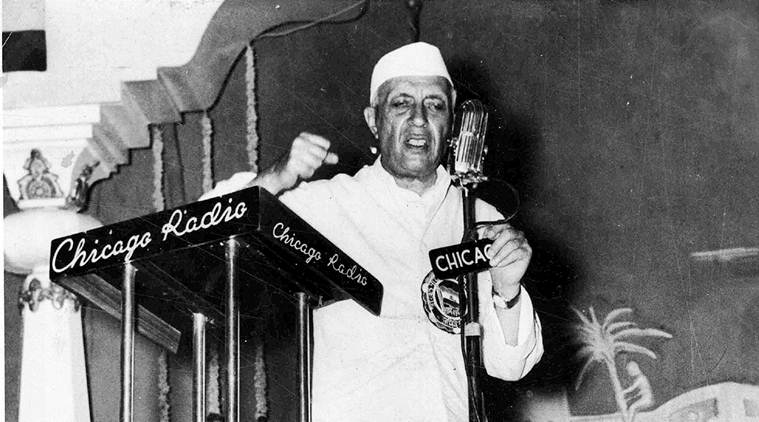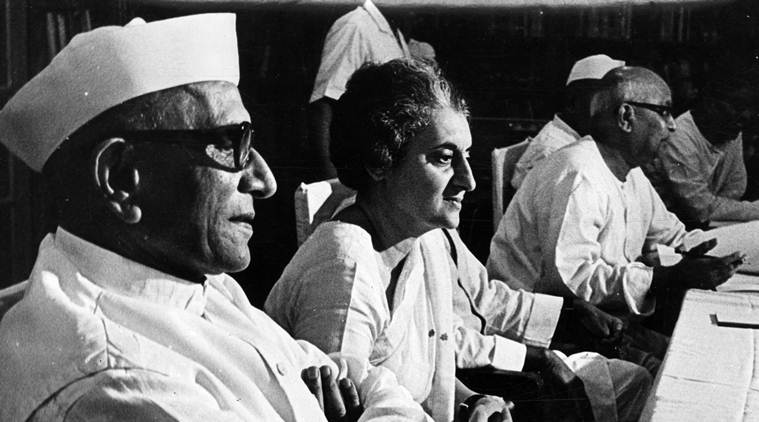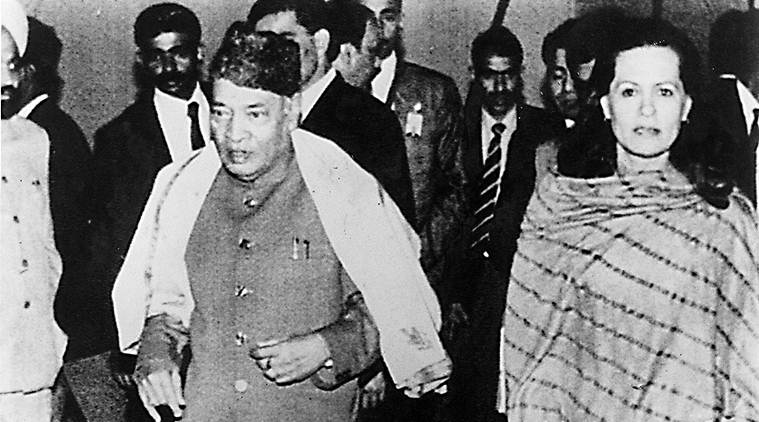Latest Comment
Post Comment
Read Comments
 Congress president Rahul Gandhi with party senior Leader Sonia Gandhi during the CWC Meeting at New Delhi. (Express Photo by Renuka Puri)
Congress president Rahul Gandhi with party senior Leader Sonia Gandhi during the CWC Meeting at New Delhi. (Express Photo by Renuka Puri)
The Congress, which has governed India for most of the seven-odd decades after Independence, is facing an existential crisis after being reduced to double digits in the Lok Sabha for a second consecutive time. A look through history at previous electoral routs and internal crises faced by the party:
In the years immediately after Independence and Mahatma Gandhi’s assassination, the Congress faced its first big crisis in the form of a right-wing assertion within. Jawaharlal Nehru had to struggle against the likes of Purushottam Das Tandon, K M Munshi and Narhar Vishnu Gadgil to ensure that his philosophy, particularly of secularism, prevailed within the party. Things came to a head ahead of the AICC session in September1950 when Tandon announced his decision to contest for Congress president. It was the first open election for the post in independent India.
 Jawaharlal Nehru faced right-wing assertion and the first open election for party presidency. (Express archive photo)
Jawaharlal Nehru faced right-wing assertion and the first open election for party presidency. (Express archive photo)
The other contenders were J B Kripalani and Shankerrao Deo. The leadership of the right wing was attributed to Sardar Vallabhbhai Patel although he did not always explicitly exercise it. Tandon got over 1,000 votes more than Kripalani. This upset Nehru to the extent that he even refused to be a member of Tandon’s Working Committee. After Patel’s death in December, another flashpoint came when Tandon overruled Nehru’s wish to induct Rafi Ahmed Kidwai into the CWC. Kidwai resigned from the Congress and joined hands with Kripalani who had by then formed the Kisan Mazdoor Praja Party. Kidwai stayed on in the Cabinet for some time but eventually resigned.
In July 1951, the crisis came to a head again when Nehru resigned from the CWC. With the first general election a year away, Tandon finally relented by resigning, and Nehru was elected the Congress president at the AICC session in Delhi in October.
The Congress plunged into an even bigger crisis towards the end of the next decade. This time, it was over economic outlook. Prime Minister Indira Gandhi, under the influence of Mohan Kumaramangalam and P N Haksar, appeared inclined towards nationalisation of banks and heavy industries. Morarji Desai, on the other hand, favoured the mixed economy model developed through a consensus between the socialist and capitalist streams in the party during the Nehru years. Indira went to the AICC session in Lalbagh in July 1969 where the ‘Note on Economic Policy and Programme’ was circulated among the delegates, outlining the shift in approach.
 Morarji Desai with former prime minister Indira Gandhi and S Nijalingappa during AICC meeting, Bangalore. Indira Gandhi was expelled by S Nijalingappa and later unseated as PM by Morarji Desai. (Express archive photo)
Morarji Desai with former prime minister Indira Gandhi and S Nijalingappa during AICC meeting, Bangalore. Indira Gandhi was expelled by S Nijalingappa and later unseated as PM by Morarji Desai. (Express archive photo)
This brought a firm reaction from Desai, culminating in a power tussle between Indira and the “Syndicate”. The occasion was the election of the President of India the following month. Indira’s authority was challenged with the announcement of Neelam Sanjeeva Reddy as the Congress’s presidential candidate. She took the challenge head on and backed V V Giri. Slighted, Congress president S Nijalingappa prepared for a showdown, and Indira sought his removal.
Parallel CWC meetings were held, one at the Congress headquarters and the other at the Prime Minister’s residence in the first week of November. Days later, Nijalingappa expelled Indira, the Prime Minister, from the Congress. The party officially split. She was forced to adopt a new electoral symbol — the cow-and-calf. In December, both factions held AICC sessions. The Indira faction elected Jagjivan Ram as president in the Bombay session on December 28 and 29. The Congress (O) led by the Syndicate even brought a no-confidence motion against Indira’s government but it was defeated. She called for elections in 1971 and came back with a two-thirds majority.
Indira’s imposition of Emergency in June 1975 was followed by the Congress’s heavy defeat in the election, called by Indira after lifting Emergency in 1977. She herself was defeated in Rae Bareli. The party split again with Jagjivan Ram breaking away. The Congress and Indira spent the next two years in the political wilderness while Prime Minister Desai looked entrenched. Indira and some members of her erstwhile Cabinet were arrested on charges of corruption. But the tide turned in the Congress’s favour.
Chandra Shekhar, president of the ruling Janata Party, raised the issue of dual membership of former Jana Sangh members. Those in the government, including Atal Bihari Vajpayee and L K Advani, had to choose between staying in the government and being members of the RSS. Vajpayee and Advani chose the latter and the government collapsed soon. Desai’s successor Charan Singh could not run a stable government and Indira powered the Congress back to power in 1980.
Indira’s assassination in 1984 created a massive sympathy wave for the Congress that returned her son Rajiv Gandhi to power with over 400 seats. But his flirtations with political Hindutva — he persuaded Uttar Pradesh CM Bir Bahadur Singh to open the lock of Babri Masjid and allow religious rites in 1986 — triggered unrest in the party and the Bofors scandal brought it down. V P Singh, who as Finance Minister and later as Defence Minister had raised questions about corruption, walked out of the Congress, and launched Jan Morcha with many disillusioned Congress leaders.
 Rajiv Gandhi’s party was routed after V P Singh walked out. (Express archive photo)
Rajiv Gandhi’s party was routed after V P Singh walked out. (Express archive photo)
In the 1989 elections, Rajiv was defeated with the Congress reduced to 197 seats. In 1991, he became the second Congress president to be assassinated while in office. The party once again plunged into turmoil but managed to emerge the single largest in the 1991 elections, and P V Narasimha Rao took over as Prime Minister.
The Congress suffered a series of splits during the 1990s. Rao faced difficulties right after taking over, in running the government as well as the party. There was mistrust between him and veterans like Arjun Singh and N D Tiwari. At the Tirupati AICC session in April 1992, Singh won the CWC polls with the highest margin; Sharad Pawar too won. Rao asked the entire newly elected CWC to resign on the pretext that there was not enough representation of women and Dalits. He then reconstituted the CWC and included Singh in the nominated category.
Trouble was far from over. After the demolition of the Babri Masjid, Singh started spreading the view that Rao was not sufficiently secular. A power struggle ensued in which Rao lost the support of Sonia Gandhi because he was not seen as active enough on the question of Rajiv’s assassination. The big break came when Sri Lankan President Chandrika Kumaratunga informed Sonia that the Government of India had not even asked for extradition of people connected with the assassination.
 P V Narasimha Rao lost Sonia Gandhi’s trust amid power tussle. (Express archive photo)
P V Narasimha Rao lost Sonia Gandhi’s trust amid power tussle. (Express archive photo)
In 1994, the Congress lost in Rao’s home state Andhra Pradesh which emboldened his critics. The feud resulted in Singh’s ouster from the Cabinet and suspension from the party, and another split. A breakaway faction was formed with N D Tiwari as president and Singh as working president. After running a minority government for five years, the Congress lost power in 1996.
It would take the Congress another eight years to return to power. Rao resigned and AICC treasurer Sitaram Kesri took over, but he was challenged by other senior leaders. The two years following the 1996 defeat saw backroom manoeuvring and intrigue in the Congress. In the 1997 Congress presidential election, Kesri defeated Pawar and Pilot. Two years later, he was booted out of the party after Sonia indicated her willingness to take over.
But soon after Sonia taking over in March 1998, the Congress plunged into another crisis. Just before the 1999 Lok Sabha elections, Sharad Pawar, P A Sangma and Tariq Anwar raised a banner of revolt, and were removed. Before Sonia could consolidate her position, Jitendra Prasada threw a challenge in 2001 when he contested against her for the post of Congress president. Sonia won.